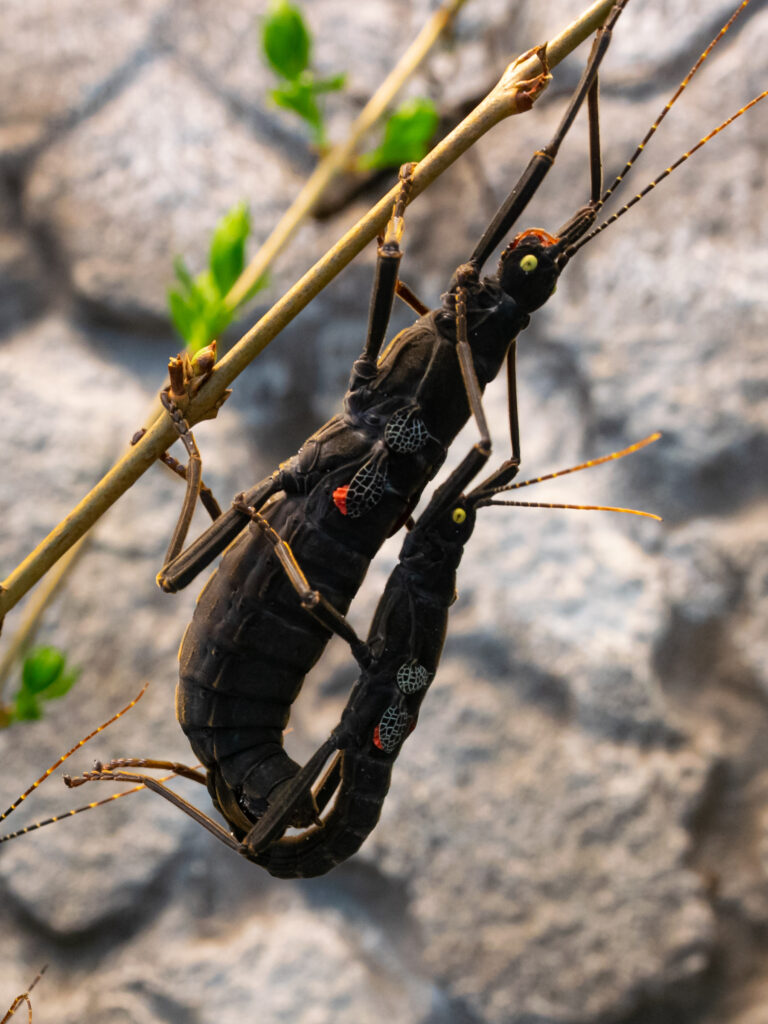Among the wonders of the natural world, stick insects hold a special place for their remarkable ability to blend seamlessly into their surroundings by bearing a striking resemblance to a twig!
Let’s dive into the world of stick insects, exploring their characteristics, habitats, and unique adaptations.
What is a stick insect?
Stick insects, belonging to the order Phasmatodea, are renowned for their resemblance to sticks or twigs. With over 3,000 species, including leaf insects, they share lineage with grasshoppers, crickets, and mantises.
They can be found in the tropics and subtropics, usually in humid forests close to their herbivorous diet!
Because of their unique shape, they are the longest group of insects in the world.
Characteristics of a stick insect
At the core of the stick insect’s identity lies its unmatched camouflage skills. These creatures effortlessly blend into their environment, adopting shades of brown or green to avoid detection by predators.

While many stick to the classic stick-like appearance, some, like the black beauty stick insect (Peruphasma schultei), sport bold colours as a warning of their irritating venom that they’re capable of shooting. Females are typically larger than males, reaching lengths of up to 33cm. Their bodies, whether cylindrical or flat, feature compound eyes, segmented legs, and occasionally wings, the size of which varies among species, with the largest being Phryganistria chinensis that measured approximately 62cm.
Where do stick insects live?
Stick insects inhabit diverse habitats, from tropical regions to woodlands, across all continents except Antarctica. They prefer leafy shelters where their camouflage is most effective, remaining motionless during the day and active at night.
What do stick insects eat?
As herbivores, stick insects primarily feed on leaves, using their powerful mandibles to consume foliage. Their diet may vary based on habitat and plant availability. Stick insects feed almost constantly on fresh leaves because of their voracious appetite.
Reproduction and lifecycle of a stick insect
The reproductive behaviour of stick insects involves courtship and mating rituals lasting several weeks. Chemical signals are released to attract potential mates. Some species reproduce through parthenogenesis, with females fertilising their own eggs. The lifecycle includes embryonic development within the egg, followed by the nymph stage marked by gradual growth and moulting, culminating in adulthood after several months to a year. Stick insects typically live for 2 to 3 years.

Interesting facts about the stick insect
Egg-cellent camouflage
It’s not just their bodies that are camouflaged, they even have camouflaged eggs, that mimic plant seeds.
Amazing defences
If they’re still found even with their amazing camouflage, some species have incredible defence mechanisms such as sharp spines or chemical emissions that help to deter predators.
Don’t leave a trace
After moulting, stick insects eat their exoskeletons to avoid leaving any trace of themselves behind! They are masters of disguise and subterfuge!
Blind as a bat
Just because they can fool most creatures’ eyes, doesn’t mean they can fool a bat’s echolocation. A stick insect’s main predators are bats that sense them through sound as opposed to sight.
Stick insects exemplify adaptation and survival in the natural world. Their remarkable camouflage and intricate life cycles continue to fascinate both zoologists and nature lovers alike. For those curious about these elusive creatures, and those eager to encounter the black beauty stick insect firsthand, a visit to the Venom exhibit at Blue Planet Aquarium offers insights into these masters of camouflage.
